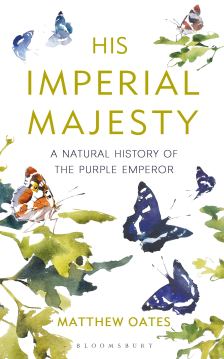You may remember a short while ago when I reviewed The Butterfly Isles by Patrick Barkham, it was during this book that I first me the eccentric character that is Matthew Oates. In Barkham’s book, Oates helps him to see one of the most alluring of all of the British butterflies, the purple emperor. Having spoken to a few colleagues of mine who work with butterflies, I quickly learnt that Oates is a heavyweight in the butterfly world, especially when it comes to this elusive beauty. To my amazement, Oates has authored a biography of the purple emperor titled His Imperial Majesty, given the audacity of this butterfly it is not merely a natural history. The purple emperor is one species of butterfly that I am still yet to see in the wild, although after having read Oates’ account of this species, I am sure it won’t be long until I am graced a presence with the Emperor himself. From this fantastic monograph, it seems that late June/early July is the best time to observe this species. I think I may have caught the bug Oates describes so many times, without ever having laid eyes on the provocative lepidopteran myself.
It is very clear from Oates’ historical sketch of the purple emperor at the very beginning of this book, that the species has captivated naturalists for generations, with some becoming completely obsessed. In my mind, it is always worth having some historical context like this to help build a picture of where our current understanding of a species/habitat came from. The purple emperor is no ordinary butterfly, they have a unique personality about them which sees this insect which weighs less than a gram, aggressively flying at birds, livestock, and people. No wonder that naturalists in the past were consumed by His Imperial Majesty, so much so that they would better belong in a Lewis Carroll novel. However, these historical characters helped to set the groundwork for the work that Oates and his colleagues have been completing over the past few decades. Once thought to be a rare species, the purple emperor instead is now seen as a more common one, although surveying them is tricky as they like to fly between 5-10 metres high in the canopy!
It is clear reading His Imperial Majesty that Oates has a very fond fascination for the purple emperor, just as I do for grass snakes or midwife toads. There is still a lot we don’t know about the species, and Oates outlines some of this within, in the hope that some scientists out there are listening. One of the reasons why this butterfly was thought to be rare for so long, was the fact that we penalised its foodplant – sallows. They have often been seen as weeds, and removed as a consequence. Having a number of all signing and all dancing butterflies is great, but they’re not going to be there if they don’t have the required foodplant. Then comes the trickiness of surveying for them, I’m glad that surveying for temperate reptiles and amphibians is not as hard. Hats off to everyone that completes surveys for His and Her Imperial Majesties. The future of purple emperors in Britain is bright, although that may all change as climate change progresses – so watch this space! For now, if you want to know more about the intoxicating charm of a dark purple butterfly, look no further! Oates is an amazing wordsmith, which makes reading this book which champions purple emperors even more enjoyable.

If you liked this post and enjoy reading this blog, please consider supporting me on Patreon where you will also gain access to exclusive content. If you’d like to buy a book from my Amazon Wish List, please follow this link.





1 COMMENTS